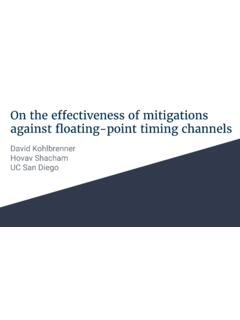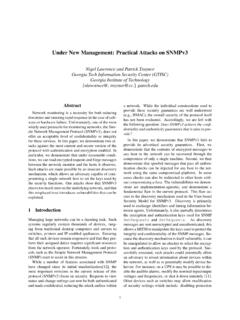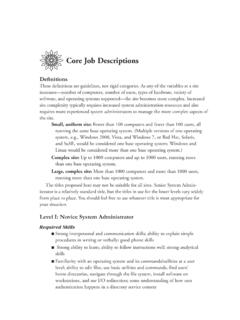Transcription of Announcement and Call for Papers www.usenix.org/atc22/cfp ...
1 Announcement and call for Papers 11 13, 2022, Carlsbad, CA, USA2022 USENIX Annual Technical ConferenceThe 2022 USENIX Annual Technical Conference will be co-located with the 16th USENIX Symposium on Operating Systems Design and Implementation (OSDI 22) and take place on July 11 13, 2022, at the Omni La Costa Resort & Spa in Carlsbad, CA, Dates Abstract registrations due: Thursday, January 6, 2022, 11:59 pm UTC Submissions due: Thursday, January 13, 2022, 11:59 pm UTC Beginning of authors response period: Monday, April 11, 2022 Authors response due: Wednesday, April 13, 2022, 11:59 pm UTC Notification to authors: Friday, April 29, 2022 Final paper files due: Thursday, June 9, 2022 Conference Organizers Program Co-ChairsJiri Schindler, Tranquil DataNoa Zilberman, University of OxfordProgram CommitteeReto Achermann, University of British ColumbiaGustavo Alonso, ETH ZurichRaja Appuswamy, EURECOMAnys Bacha, University of MichiganSaurabh Bagchi, Purdue UniversityYungang Bao, Institute of Computing Technology, Chinese Academy of SciencesAntonio Barbalace, University of EdinburghYaniv Ben Itzhak, VMware ResearchAnnette Bieniusa, TU KaiserslauternRoberto Bifulco, NEC Laboratories EuropeLaurent Bindschaedler, Massachusetts Institute of TechnologyWilliam Bolosky, Microsoft ResearchJames Bottomley, IBM ResearchNathan Bronson, RocksetMihai Budiu, VMware ResearchSomali Chaterji, Purdue UniversityRev.
2 01/05/22 Sponsored by USENIX, the Advanced Computing Systems AssociationLydia Chen, Delft University of TechnologyYoung-ri Choi, UNIST (Ulsan National Institute of Science and Technology)David Cock, ETH ZurichDilma Da Silva, Texas A&M UniversityAngela Demke Brown, University of TorontoFred Douglis, Peraton LabsAbhinav Duggal, Dell EMCP ascal Felber, University of NeuchatelPedro Fonseca, Purdue UniversityWei Gao, University of PittsburghEran Gilad, Yahoo ResearchYotam Harchol, DFINITY FoundationTim Harris, MicrosoftNiranjan Hasabnis, Intel LabsDavid Hay, Hebrew UniversityMichio Honda, University of EdinburghJon Howell, VMwareYu Hua, Huazhong University of Science and TechnologyRebecca Isaacs, Twit terZsolt Istvan, TU DarmstadtAnand Iyer, Microsoft ResearchBill Jannen, Williams CollegeTheo Jepsen, Stanford UniversityAnuj Kalia, MicrosoftMichael Kozuch, Intel LabsJohn Kubiatowicz, University of California, BerkeleyYoungjin Kwon, Korea Advanced Institute of Science and Technology (KAIST)
3 S ndor Laki, ELTE E tv s Lor nd UniversityShir Landau Feibish, The Open University of IsraelAlberto Lerner, University of FribourgYouyou Lu, Tsinghua UniversityXiaosong Ma, Qatar Computing Research InstituteA. Theodore Markettos, University of CambridgeAli Mashtizadeh, University of WaterlooMichael Mesnier, IntelEthan Miller, University of California, Santa Cruz / Pure StorageChangwoo Min, Virginia TechJayashree Mohan, Microsoft Research IndiaSue Moon, Korea Advanced Institute of Science and Technology (KAIST)Kiran-Kumar Muniswamy-Reddy, AmazonOnur Mutlu, ETH ZurichShadi Noghabi, Microsoft ResearchFernando Pedone, Universit della Svizzera italianaAdrian Perrig, ETH ZurichBabu Pillai, Intel LabsThanumalayan Pillai, GoogleFernando Ramos, Universidade de LisboaKaveh Razavi, ETH ZurichLarry Rudolph, Two Sigma Investments, LPRussell Sears, AppleMark Silberstein, Technion Israel Institute of TechnologyGeorgios Smaragdakis, Delft University of TechnologyKeith Smith, MongoDBRipduman Sohan, XilinxPatrick Stuedi, ConfluentVasily Tarasov, IBM Research - AlmadenJens Teubner, TU DortmundEno Thereska, AmazonDaniel Thomas, University of StrathclydeTheodore Ts o, GoogleShay Vargaftik, VMWare ResearchNandita Vijaykumar, University of TorontoHaris Volos, University of CyprusKeval Vora, Simon Fraser UniversityHan Wang, IntelRic Wheeler, FacebookAvani Wildani, Emory UniversityDan Williams, Virginia TechYoujip Won, Korea Advanced Institute of Science and Technology (KAIST)
4 Eiko Yoneki, University of CambridgeOverviewThe 2022 USENIX Annual Technical Conference (USENIX ATC 22) seeks original, high-quality submissions that improve and further the knowledge of computing systems, with an emphasis on implementations and experimental results. We are interested in systems of all scales, from small embedded mobile devices to data centers and clouds. The scope of USENIX ATC covers all practical aspects related to computer systems, including but not limited to: operating systems; runtime systems; parallel and distributed systems; storage; networking; security and privacy; virtualization; software-hardware interactions; performance evaluation and workload characterization; reliability, availability, and scalability; energy and power management; and bug-finding, tracing, analyzing, and value submissions more highly if they are accompanied by clearly defined artifacts not previously available, including traces, original data, source code, or tools developed as part of the submitted work.
5 We particularly encourage new ideas and must contain original unpublished material that is not under review at any other forum, including journals, confer-ences, and workshops with proceedings. They will be judged on relevance, novelty, technical merit, correctness, and clarity. An idea or a design that the PC committee deems flawed can be grounds for ATC 22 will employ double-blind reviewing. Papers that are not properly anonymized may be rejected without need to be registered and their abstracts submitted by the abstract registration deadline. Papers with an empty abstract will be Type: Full vs. ShortUSENIX ATC accepts both full and short submissions. Short submissions are limited to roughly half the space of full-length submissions. Both types are reviewed to the same standards and differ primarily in scope. A short paper presents a com-plete idea that is properly evaluated, just like in a full-length Systems TrackUSENIX ATC 22 solicits Papers that describe the design, implementation, analysis, and experience with large-scale, op-erational systems and networks.
6 Such operational Papers need not present new ideas or results to be accepted. Note that the rules regarding submission and anonymization are different for operational systems track Papers (see the submission instruc-tions for more details). The final program will explicitly identify Papers accepted from the operational track to distinguish Papers accepted from the regular Rejection NotificationsUSENIX ATC 22 will conduct its reviews in multiple rounds. As some Papers may be rejected in an early round, USENIX ATC 22 will send early rejection notifications to such authors at least a month ahead of the date that all remaining notifications are sent (acceptances and additional rejections).Authors Response PeriodUSENIX ATC 22 will provide an opportunity for authors to re-spond to reviews prior to final consideration of the submissions at the program committee meeting according to the schedule detailed submissions will be treated as confidential prior to publica-tion on the USENIX ATC 22 website.
7 Rejected submissions will be permanently treated as direct any questions to the program co-chairs at or to the USENIX office at InstructionsProcess OverviewA good submission will typically: motivate a significant problem; propose a practical solution or approach that makes sense; demonstrate the pros and cons of the latter using sound experimental and statistical evaluation methods; disclose what has and has not been implemented; articulate the new contri-butions beyond previous work; and refrain from over-claiming, focusing the abstract and introduction sections primarily on the difference between the new proposal and what is already available. Submissions will be judged on relevance, novelty, technical merit, correctness, and clarity. An idea or design that the PC committee deems flawed can be grounds for are required to avoid committing benchmarking crimes ( ~ ).Authors of resubmitted work need to describe in a separate note the changes since the previous submission(s).
8 This description helps reviewers who may have reviewed a previous draft of the work to appreciate any improvements to currently submitted need to be registered and their abstracts submitted by the abstract registration deadline. Papers with an empty abstract will be must be submitted before the aforementioned sub-mission deadline via the submission system linked from the USENIX ATC 22 call for Papers web page. Submissions must be in PDF format. No extensions will be given. Submissions must strictly adhere to the policies specified below. By submitting, you agree that if the paper is accept---ed, at least one of the authors will attend the conference. Submissions accompanied by nondisclosure agreement forms will not be must contain original unpublished material that is not under review at any other forum, including journals, conferences, and workshops with proceedings. Submissions that extend your own previous work in a significant way are welcome, but you must explain the differences between your current USENIX ATC submission and your prior work.
9 You should also relate your current USENIX ATC submission to rel-evant submissions of your own that are simultaneously under review for this or other venues. The next section discusses how to do so while maintaining submission of the same work to multiple venues, submission of previously published work, or other violations of the above policies constitute plagiarism, dishonesty, or fraud. USENIX prohibits these practices and may take action against authors who have committed them; see the USENIX Conference Submissions Policy ( ) for additional Type: Full vs. ShortShort submissions are limited to roughly half the space of full-length submissions. Both types are reviewed to the same standards. A short paper is not like a workshop position paper it presents a complete idea that does not require full length to be appreciated. The idea should be concisely formu-lated and evaluated, and conclusions should be drawn from it. The program committee may, in rare cases, decide to accept a full submission on the condition that it is cut down to fewer pages.
10 Short Papers will be included in the proceedings and presented at the conference like full Papers during a slightly shorter time submissions must not exceed 11 pages, and short sub-missions must not exceed 5 pages, including all text, figures, tables, footnotes, etc. Submissions may include as many additional pages as needed for references and for supplemen-tary material in appendices. Because references do not count against the page limit, they should not be formatted using a smaller font, and the names of all co-authors should be speci-fied. The paper should stand alone without the supplementary material, but authors may use this supplementary material space for content that may be of interest to some readers but is peripheral to the main technical contributions of the paper. Note that members of the program committee are free to not read this material when reviewing the US letter paper size ( x 11 or 216 mm x 279 mm), with all text and figures fitting inside a 7 x 9 (178 mm x 229 mm) block centered on the page, using two columns separated by (8 mm) of a 10-point font (typeface Times Roman, Linux Libertine, etc.)










